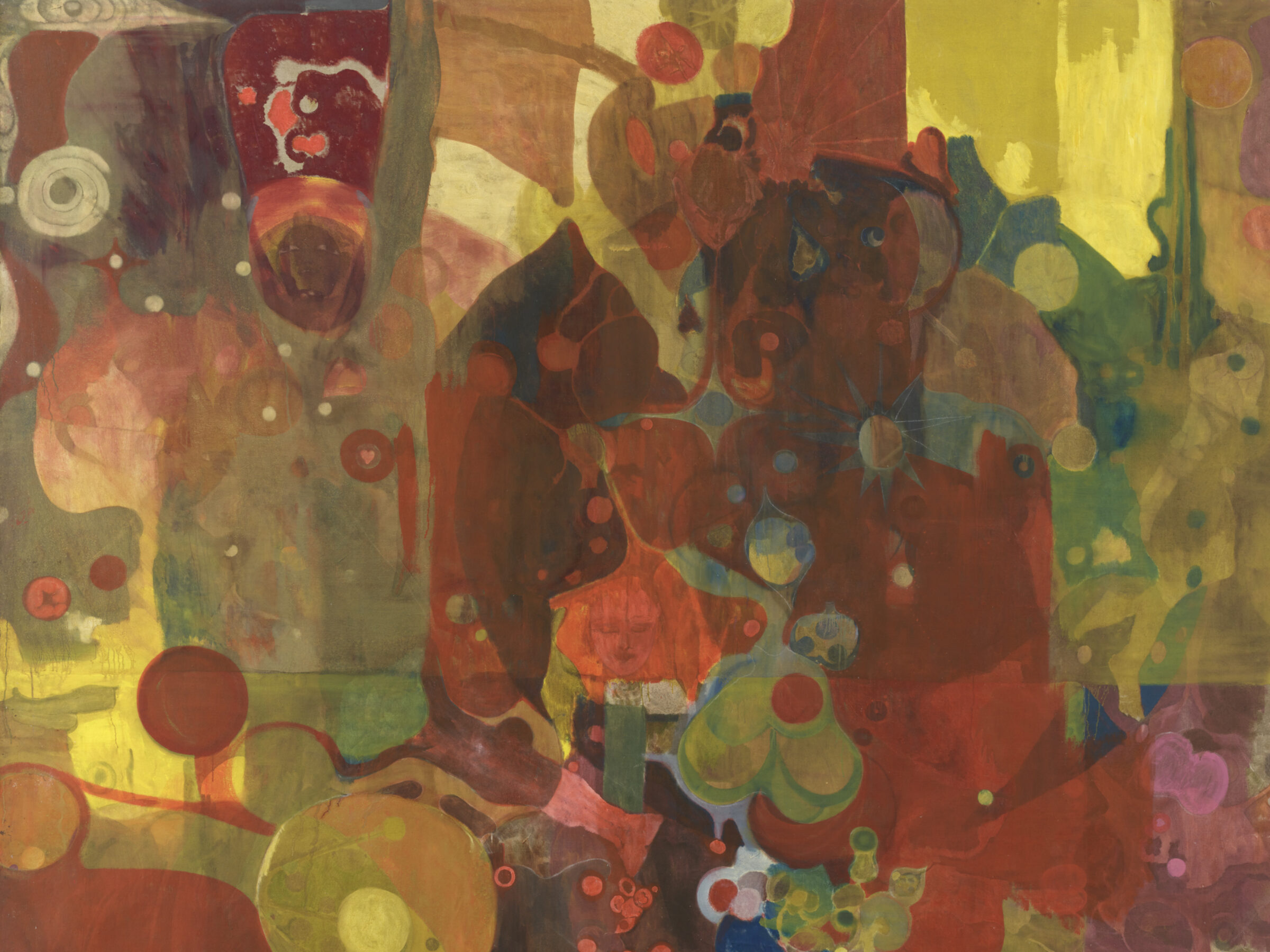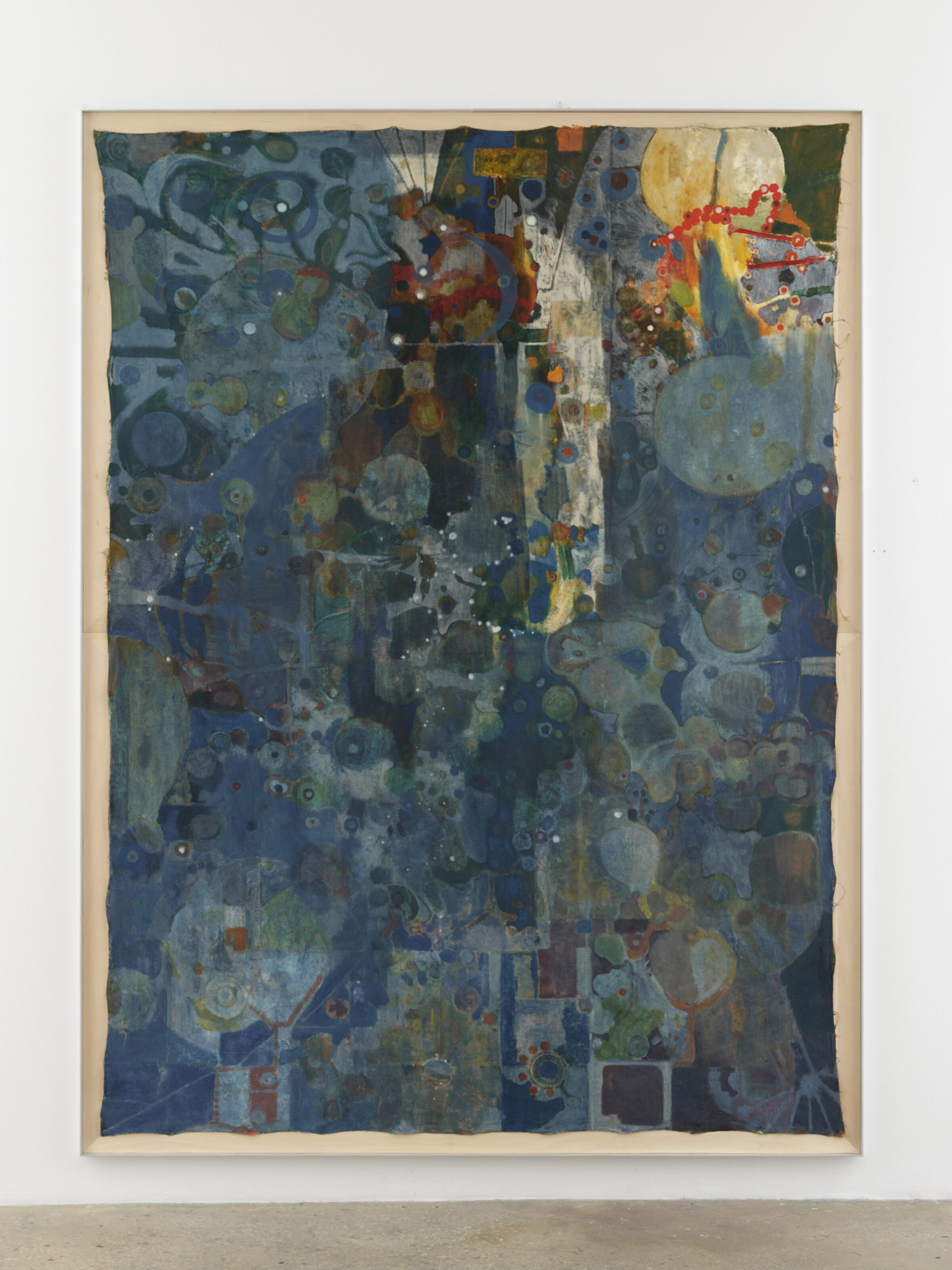JUSTIN CAGUIAT reviewed by Dean Kissick for Spike Art Magazine
Greene Naftali
Exhibition
JUSTIN CAGUIAT
Carnival
Ground Floor


Justin Caguiat, Installation view, Carnival, Greene Naftali, New York, 2022
Greene Naftali is pleased to announce its first solo exhibition by Justin Caguiat, whose numinous, dreamlike paintings depict realms beyond the visible. Intimately rendered at a towering scale on lengths of unstretched linen, Caguiat’s dense surfaces metabolize a range of sources: from the flattened forms of manga or woodblock prints to century-old Japanese erotica; the folk-baroque fusions of Filipino Catholic icons to the Vienna Secession’s jewel-box modernism. A certain opulence or visual hedonism stems from that mix of registers and cultural ties, creating inner landscapes that revel in a toxic sublime.

Justin Caguiat
Daisyworld, 2022
Oil and gouache on linen, artist frame
Painting: 126 1/2 x 162 1/2 inches (321.3 x 412.8 cm)
Frame: 131 x 166 x 2 inches (332.7 x 421.6 x 5.1 cm)

Justin Caguiat, Daisyworld, 2022 (detail)

Justin Caguiat, Daisyworld, 2022 (detail)

Justin Caguiat, Installation view, Carnival, Greene Naftali, New York, 2022

Justin Caguiat
Nirvana, 2022
Oil and gouache on linen, artist frame
Painting: 126 1/2 x 148 inches (321.3 x 375.9 cm)
Frame: 129 1/2 x 151 3/4 x 2 inches (328.9 x 385.4 x 5.1 cm)

Justin Caguiat, Nirvana, 2022 (detail)

Justin Caguiat, Installation view, Carnival, Greene Naftali, New York, 2022

Justin Caguiat, Installation view, Carnival, Greene Naftali, New York, 2022

Justin Caguiat
Cupio Dissolvi, 2022
Oil on linen, artist frame
Painting: 127 1/2 x 94 inches (323.9 x 238.8 cm)
Frame: 131 x 98 x 2 inches (332.7 x 248.9 x 5.1 cm)

Justin Caguiat, Cupio Dissolvi, 2022 (detail)

Justin Caguiat, Cupio Dissolvi, 2022 (detail)

Justin Caguiat, Installation view, Carnival, Greene Naftali, New York, 2022

Justin Caguiat
Infiltrating Substance of Appearance, 2022
Oil and gouache on linen, artist frame
Painting: 85 x 112 inches (215.9 x 284.5 cm)
Frame: 89 x 118 x 2 inches (226.1 x 299.7 x 5.1 cm)

Justin Caguiat, Installation view, Carnival, Greene Naftali, New York, 2022

Justin Caguiat
Proportionality, 2022
Oil and gouache on linen, artist frame
Painting: 85 x 112 1/2 inches (215.9 x 285.8 cm)
Frame: 88 3/8 x 116 1/2 x 2 inches (224.5 x 295.9 x 5.1 cm)

Justin Caguiat, Installation view, Carnival, Greene Naftali, New York, 2022

Justin Caguiat
I Love Him, 2022
Oil and gouache on linen, artist frame
Painting: 131 x 126 inches (332.7 x 320 cm)
Frame: 134 x 130 x 2 inches (340.4 x 330.2 x 5.1 cm)

Justin Caguiat, I Love Him, 2022 (detail)

Justin Caguiat, I Love Him, 2022 (detail)
Damaged figures and other lifeforms stir and recede into aqueous grounds of patterned color, which resolve on close inspection into an array of repeated motifs—neural networks, entrails, windowpanes, bodies shown whole or dissolved into parts. These nodal points are there for compositional ballast, yet no element’s identity is fixed. Pools of paint could be orifices, solar flares, or discs of pure geometry; a figure in Gretel in Pharmakon (2022) may be the child innocent or the witch who torments her. Caguiat’s penchant for indeterminacy recurs in his use of pharmakon, a theoretical term that translates to both poison and remedy—it can abide its own undoing. Like occult tapestries or frescoes from a ruined future, Caguiat’s paintings are rife with signification but resist the tug of narrative, urging a directness of sensory experience that is alien to language.

Justin Caguiat
Gretel in Pharmakon, 2022
Oil and gouache on linen, artist frame
Painting: 132 x 125 inches (335.3 x 317.5 cm)
Frame: 135 7/8 x 130 1/4 x 3 inches (345 x 331 x 8 cm)

Justin Caguiat, Gretel in Pharmakon, 2022 (detail)

Justin Caguiat, Gretel in Pharmakon, 2022 (detail)
That appeal to the viewer’s perceptual faculties is magnified in Hysteresis Loop (2022), a recent experiment in heightening painting’s innate capacity to shift and change before our eyes. Using heat-activated pigments and a radiant sensor rigged to the verso of a metal support, the work undergoes a set of slow but dramatic changes in color as its temperature rises and falls on programmed loop. These thermochromic pigments produce more vibrant, clarion hues than can be achieved by traditional means, deepening Caguiat’s explorations of color theory and of painting as a time-based medium—one that rewards extended looking and is inherently resistant to reproduction.

Justin Caguiat
Hysteresis Loop, 2022 (85.8 degrees Fahrenheit)
Thermochromic pigment, wax emulsion, acrylic polymer emulsion, digital temperature controller and sensor, radiant heat substrate, aluminum
72 1/8 x 96 1/8 x 1 1/2 inches (183.2 x 244.2 x 3.8 cm)

Justin Caguiat
Hysteresis Loop, 2022 (89 degrees Fahrenheit)
Thermochromic pigment, wax emulsion, acrylic polymer emulsion, digital temperature controller and sensor, radiant heat substrate, aluminum
72 1/8 x 96 1/8 x 1 1/2 inches (183.2 x 244.2 x 3.8 cm)

Justin Caguiat
Hysteresis Loop, 2022 (80.7 degrees Fahrenheit)
Thermochromic pigment, wax emulsion, acrylic polymer emulsion, digital temperature controller and sensor, radiant heat substrate, aluminum
72 1/8 x 96 1/8 x 1 1/2 inches (183.2 x 244.2 x 3.8 cm)

Justin Caguiat
Intuition of the Ecstasy, 2022
Oil and gouache on linen, artist frame
Painting: 130 x 126 1/2 inches (330.2 x 321.3 cm)
Frame: 133 1/2 x 129 1/2 x 2 inches (339.1 x 328.9 x 5.1 cm)

Justin Caguiat, Intuition of the Ecstasy, 2022 (detail)

Justin Caguiat, Intuition of the Ecstasy, 2022 (detail)

Justin Caguiat, Installation view, Carnival, Greene Naftali, New York, 2022
The exhibition shares its title, Carnival, with one of Caguiat’s early videos, shown here for the first time. Shot a decade ago in the industrial Midwest on a handheld VHS camcorder, the footage makes for an impressionistic, haunting document of both celebration and neighborhood havoc. A field recording from an earlier phase of the artist’s life, Carnival finds grace notes within observed scenes of low-slung peril—a burning house against a cloudless blue sky.

Justin Caguiat
Carnival, 2012
Digital video
8 minutes

Justin Caguiat, Carnival, 2012 (still)

Justin Caguiat, Carnival, 2012 (still)
